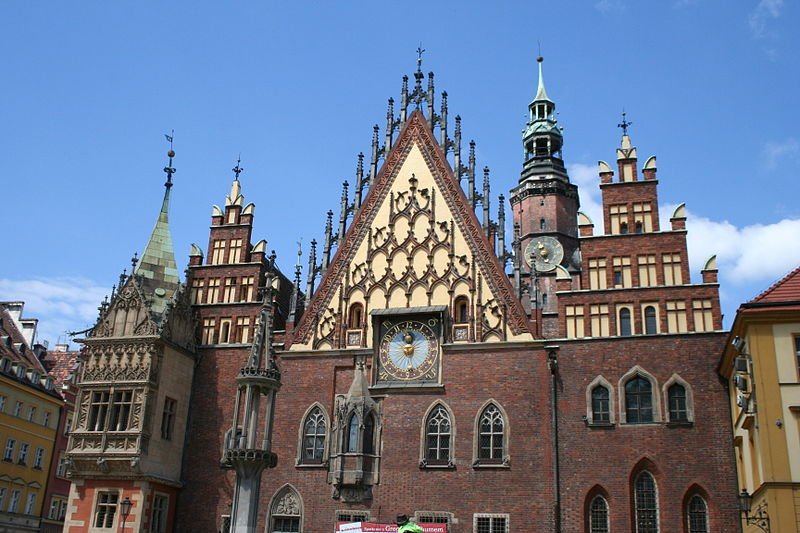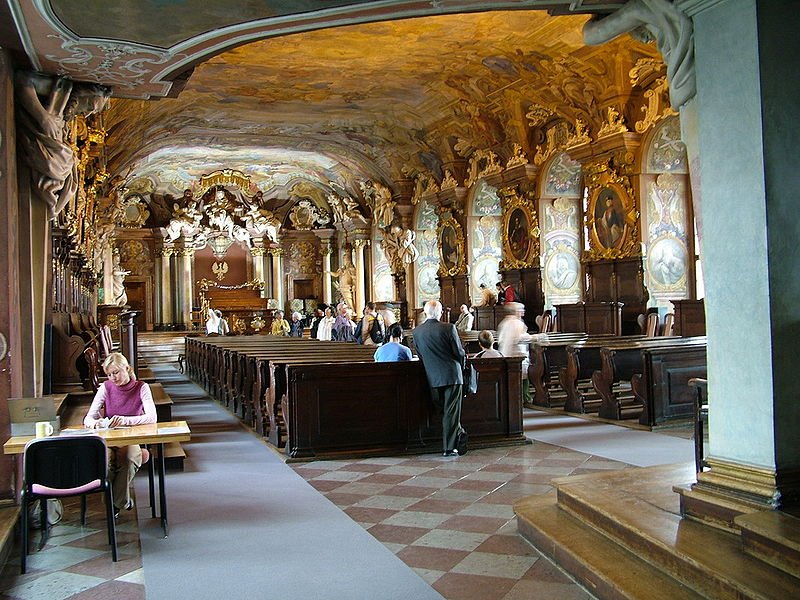 Main Building, University of Wrocław, Poland
Main Building, University of Wrocław, PolandSource: https://commons.wikimedia.org/wiki/File:Wroc%C5%82aw_-_budynek_Uniwersytetu_Wroc%C5%82awskiego.jpg
Author: Adam Dziura

Wrocław is a city on the River Oder in southwestern Poland. It covers 292 sq km (113 sq mi) and has a population of 633,000 (2011 estimate), making it the fourth largest city in Poland. The city is the provincial capital of Lower Silesian Voivodeship.
 View of Wrocław Old Town
View of Wrocław Old TownSource: https://commons.wikimedia.org/wiki/File:Czarownic1.jpg
Author: Vorwerk

More on Wrocław
Wrocław enjoys one of the warmest climate in Poland. Average high temperature of July reaches 24.6°C (76.3°F). July is also the wettest month, receiving 75 mm (2.95 in) of rain. January is the coldest month, when the average low temperature drops to -3.7°C (25.3°F).Its located near the border with the Czech Republic means that Wrocław bears much influence from its neighbor. The city was in fact founded by a Czech duke in the 10th century. A century later a Polish bishopric was established here. As with so many other cities in Poland, Wrocław has been ruled by various powers including Poland, Bohemia, Austria, Prussia and Germany.
 Historic town houses at Wrocław's Main Market Square
Historic town houses at Wrocław's Main Market SquareSource: https://commons.wikimedia.org/wiki/File:Wroc%C5%82aw_-_Rynek_1.JPG
Author: Lestat

Visiting Wrocław
The Wrocław International Airport gets flights from major cities in Europe. Arriving at the airport, you can take public bus 406 from the terminal building to downtown Wrocław.Sights & Attractions in Central Wrocław
- Church of the Holy Name of Jesus (Kościół Imiena Jezus)
Jesuit church built in the late 17th century. It stands as an outstanding example of the Silecian Baroque style. - Panorama of Racławice
A panorama painting measuring 120 meters long and 15 meters high depicting the Battle of Racławice. - Plac Biskupa Nankera
A city square surrounded by various buildings of interest including the 13th-15th century Gothic Church of St Vincent, the small 13th century Church of St Clare, the Gothic Church of St Maciej and the House of the Nuns of Trebnica. - Wrocław University
The leading center of learning in Poland since 1945. Of interest to tourists is its imposing assembly hall, built in the Baroque style.
 Wrocław Town Hall
Wrocław Town HallSource: https://commons.wikimedia.org/wiki/File:Wroclaw-2007-cityhall-019.JPG
Author: Myriam Thyes

Sights & Attractions in Wrocław Old Town
- Bernadine Church and Monastery (Kościół i Klasztor pobernardyński)
A group of religious buildings dating to 1462 built by the Bernadine monks. Today they house the only Museum of Architecture in Poland. - Cathedral of St Mary Magdalene (Katedra św. Marii Magdaleny)
Gothic-style cathedral first built in 1330. - Church of Saints Wenceslas, Stanisław and Dorothy (Kościół św św Waclawa, Stanis&3322;awa i Doroty)
The church dedicated to the Czech St Wenceslas, the Polish St Stanisśaw and the German St Dorothy was first built in 1351 to forge good relation among the three nations. - Church of St Elizabeth (Kościół św Elżbiety)
One of the biggest churches in Wrocław, located at the Main Market Square. - Kamelion Store
An unusual building built by German architect Erich Mendelsohn as a shop. - Main Market Square
The market square of Wrocław is the second biggest in Poland after that of Kraków. It is lined by historic buildings and town houses. - Royal Palace of Wrocław
The Baroque palace built in 1719 today housing the Ethnographical Museum and Archaeological Museum. - Wrocław Town Hall
Civic building that houses the Historical Museum.
 National Museum, Wrocław
National Museum, WrocławSource: https://commons.wikimedia.org/wiki/File:Wroclaw-national-museum-123.JPG
Author: Thyes

Sights & Attractions on Ostrów Tumski and Piasek Island
Ostroacute;w Tumski was where the history of Wrocław began. It was originally an island on the River Oder until the 19th century. Piasek Island is another island on the Oder with a monastic complex.- Archbishop's Palace
The residence of the archbishop of Wrocław was formerly the home of the canons of the cathedral. - Archdiocesan Museum
Museum displaying Silesian religious artifacts dating back to the Gothic period. - Botanical Gardens
The Botanical Gardens of Wrocław is one of the most beautiful in Poland. - Cathedral of St John the Baptist (Archkatedra św Jana Chrzciciela)
Cathedral exhibiting different styles from different periods. - Church of St Martin (Kościół św Marcina)
Church built on an older ecclesiastical building dating to the 11th century. Present church was a reconstruction after damage in World War II. - Church of St Mary on Piasek (Kościół NMP na Piasku)
A forbiddingly large church built in the 14th century, badly damaged during the Second world War, and restored in the post-war years. - Church of the Holy Cross (Kościół św Krzyża)
Church founded by Henry IV the Pious in 1288. It comprises two tiers. The upper church was badly damaged during the Second World War.
 University of Wrocław, Poland
University of Wrocław, PolandSource: https://commons.wikimedia.org/wiki/File:Wroclaw-AulaLeopoldina1.jpg
Author: Stako

Sights & Attractions around Central Wrocław
- Geology and Mineralogy Museum
Two museums managed by the University of Wrocław displaying rocks, fossils and mineral specimens collected from all over the world. - Jewish Cemetery
This is one of the few Jewish cemeteries in Poland that somehow escaped destruction by the Nazis. - Natural History Museum
Museum exhibiting a large collection of animals and plants from around the world. - People's Hall
Originally called Century Hall, this hall was built to commemorate the centenary of the coalition's victory against Napoleon. It was designed by Max Berg and completed in 1913. - Szczytnicki Park
A large public park dating back to the 18th century on the site of the former residence of Duke Hohenlohe-Ingelfingen. - Wrocław Zoo
This is one of the best zoos in Poland. It was founded in 1865 on the banks of the River Oder.
 Latest updates on Penang Travel Tips
Latest updates on Penang Travel Tips

Copyright © 2003-2025 Timothy Tye. All Rights Reserved.

 Go Back
Go Back